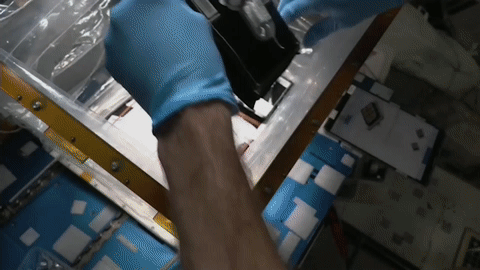ISS - Expedition 68 mission patch.
Dec 16, 2022
Crew members aboard the International Space Station conducted scientific investigations during the week of Dec 12 that included analyzing the psychological benefits of growing plants in space, testing a new space crop, and observing liquid behavior in microgravity.
International Space Station (ISS). Animation Credit: ESA
Here are details on some of the microgravity investigations currently taking place aboard the orbiting lab:
Space gardening
The Pick-and-Eat Salad-Crop Productivity, Nutritional Value, and Acceptability to Supplement the ISS Food System phased research project examines growing plants to provide fresh food and enhance the overall living experience for crew members on future long-duration missions. It includes two NASA Human Research Program investigations conducted this week.
Image above: The Veggie plant growth habitat on the International Space Station supports a variety of investigations, including HRF Veg, which examines the behavioral health benefits for crew members of having live plants and fresh food in space. Image Credit: NASA.
HRF Veg examines the behavioral health benefits of having live plants and fresh food in space. Crew members complete surveys to evaluate their moods and assess psychological benefits from interacting with the plants grown on the space station. When produce is available from other plant investigations, they rate its flavor, texture, and other qualities. During the week, crew members completed questionnaires.
Animation above: NASA astronaut Josh Cassada works on the Veg-05 investigation, which grows dwarf tomatoes and examines the effect of light quality and fertilizer on fruit production, microbial food safety, nutritional value, taste acceptability by the crew, and overall behavioral health benefits of live plants on the space station. Animation Credit: NASA.
Veg-05 uses the station’s Veggie facility to grow dwarf tomatoes and examine the effects of light quality and fertilizer on fruit production, microbial safety, nutritional value, taste acceptability, and overall behavioral health benefits. The hardware, similar to a miniature greenhouse, could be adapted for horticultural therapy for elderly or disabled individuals and to provide fresh produce for those without access to a yard on Earth. Crew members installed plant pillows in the Veggie facility, set light time intervals, and took photos during the week.
Looking at liquids
Animation above: JAXA astronaut Koichi Wakata conducts operations for Liquid Behavior, a JAXA investigation that observes liquid behavior inside a container. Results could support improved design of equipment for future space missions. Animation Credit: NASA.
Fluid behaves differently in microgravity than on Earth, which can affect the performance of fluid-based systems. The Liquid Behavior investigation from the Japan Aerospace Exploration Agency (JAXA) observes liquid behavior inside a container. Better prediction of how fluids behave could support optimal design of equipment for future space missions, including lunar rovers, life support systems, and fuel tanks. During the week, crew members installed the investigation, conducted runs, and closed out operations.
Other investigations involving the crew:
- The Plant Habitat-03 investigation assesses whether epigenetic adaptations in one generation of plants grown in space can transfer to the next generation. Results could provide insight into how to grow repeated generations of crops to provide food and other services on future space missions.
https://www.nasa.gov/mission_pages/station/research/experiments/explorer/Investigation.html?#id=8336
- STaARS BioScience–15, sponsored by the ISS National Lab, evaluates a treatment for eliminating biofilms that is safe for crew members and equipment. A better understanding of these microbial communities in space could improve biofilm control on future missions, including Artemis and voyages to Mars.
https://www.nasa.gov/mission_pages/station/research/experiments/explorer/Investigation.html?#id=8832
- RFID Smart Sensing extends the reach of radio frequency identification (RFID) signals to behind stowage racks and places motion sensors on rack doors. Results could increase the accuracy of inventory and item location and free up more crew time for scientific investigations and other activities.
https://www.nasa.gov/mission_pages/station/research/experiments/explorer/Investigation.html?#id=8319
- JAXA Low Temp Protein Crystallization Growth (PCG) grows high-quality protein crystals to determine protein structures in detail. Results could contribute to expanded use of the orbiting lab to produce crystals for development of pharmaceuticals and other biological products.
https://www.nasa.gov/mission_pages/station/research/experiments/explorer/Investigation.html?#id=2031
Space to Ground: What's Past is Prologue: 12/16/2022
The space station, a robust microgravity laboratory with a multitude of specialized research facilities and tools, has supported many scientific breakthroughs from investigations spanning every major scientific discipline. The ISS Benefits for Humanity 2022 publication details the expanding universe of results realized from more than 20 years of experiments conducted on the station.
Related links:
Expedition 68: https://www.nasa.gov/mission_pages/station/expeditions/expedition68/index.html
HRF Veg: https://www.nasa.gov/mission_pages/station/research/experiments/explorer/Investigation.html?#id=8434
Veg-05: https://www.nasa.gov/mission_pages/station/research/experiments/explorer/Investigation.html?#id=7443
Veggie: https://www.nasa.gov/mission_pages/station/research/experiments/explorer/Facility.html?#id=374
Liquid Behavior: https://www.nasa.gov/mission_pages/station/research/experiments/explorer/Investigation.html?#id=8736
ISS National Lab: https://www.issnationallab.org/
Spot the Station: https://spotthestation.nasa.gov/
Space Station Research and Technology: https://www.nasa.gov/mission_pages/station/research/overview.html
International Space Station (ISS): https://www.nasa.gov/mission_pages/station/main/index.html
Animations (mentioned), Image (mentioned), Video (NASA), Text, Credits: NASA/Ana Guzman/John Love, ISS Research Planning Integration Scientist Expedition 68.
Best regards, Orbiter.ch





